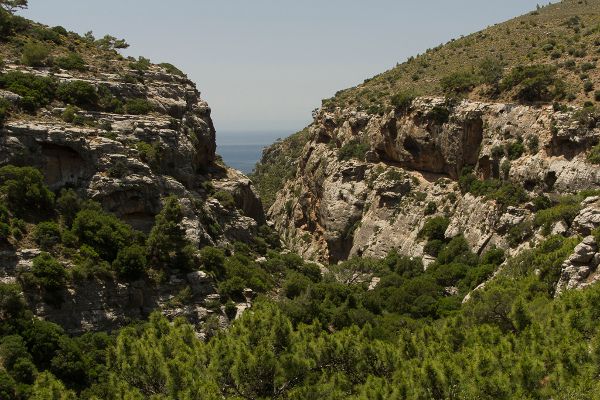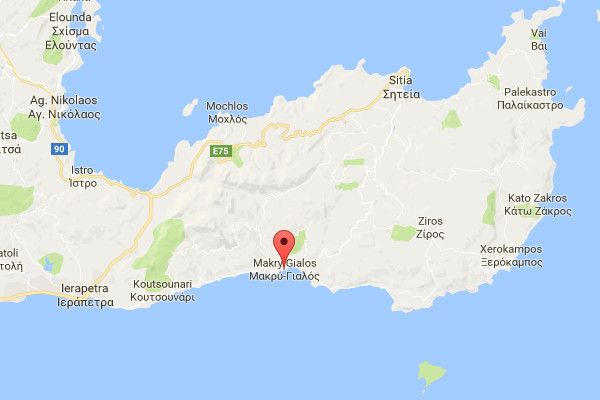Welcome to Makry Gialos, Crete
Makrygialos, Crete
The classical music festival, verdant gorges and a taste of Africa make Makrygialos a real find on Crete’s southern coast.
Situated a 35-minute drive east of Ierapetra, Makrygialos offers a tranquil contrast to Crete’s southernmost city. Whilst popular with tourists in summer, its coastline provides a selection of beaches and bays offering more seclusion than in the hub of the city.
This small town is strewn with unexpected gems to delight travellers: from a beautiful monastery cleft to the rock face, to the Gorge of Pefki verdant with life. Here in the south of the island, the climate is no longer Mediterranean but North African: the summer sun is more intense; swallows dart through the air all year round; and the classical music festival, verdant gorges and a taste of Africa make Makrygialos a real find on Crete’s southern coast.
Casa dei Mezzo
Since 2004, the beautiful villa of Casa dei Mezzo has attracted world class music to this sleepy fishing village for a few days each summer. Artists and performers from all over the world come to play in this intimate setting, nestled amid 10,000 square metres of undulating olive groves.
This is a premier concert venue for classical chamber music in Crete, where the cicadas strum along with the guitars beneath the light of the Milky Way. The Sunday Times Online have called it, “The most unique and intimate classical music Summer festival in Europe.” Lovers of classical music should visit the Casa dei Mezzo website to download the current festival programme.

Pefki Gorge
Pefki Gorge offers a beautiful excursion into nature, running from the south-western outskirts of town to the village of Pefki. Its verdant abundance of pines, plane trees, kermes oak, carobs and wild herbs offers shade from the sun and an aromatic accompaniment to your walk.
The 6.5 km are easiest to traverse starting from Pefki village, and hiking downhill to Makrygialos on the shore. A beautiful old water mill stands by the narrow path leading into the entrance of the gorge. The impressive white rock formations are unique on the island, and accompanied by the scent of the gorge’s namesake: pine trees or pefka.
A spring with fresh drinking water awaits to refresh you at the southern exit of the gorge, and stone benches along the pathway offer the opportunity to rest and enjoy the view. Shortly after exiting the gorge, you will see a notice a colossal rock known as Volakas tou Sarakinou. According to legend a Saracen pirate hid here to escape from the local Cretans.
You will then arrive in the settlement of Aspros Potamos, connected by an asphalt road to Makrygialos. Perhaps a car is already waiting for you here. If not, the village offers the opportunity to sit down and have a bite to eat before continuing the final 2 km to Makrygialos.

Monasteries of Crete
Kapsa Monastery
This enchanting monastery clings to the rock face like one of the perennial swallow’s nests, a short drive east of Makrygialos.
Follow the road eastward towards Goudouras, ignoring the prominent turn-off for Sitia. The unfolding scenery transports you to North Africa, with exposed, rocky hillsides, intense sunlight and dry, dusty surroundings. A number of emerald coves offer welcome refreshment on your way to or from the monastery.
This medieval monastery is visible from the road, clinging to the bare cliff face high above. A considerably steep driveway takes you up to the entrance. Conservative dress is required when visiting this monastery: the sign at the door prohibits “short pants”.
Inside, the stairway ascends into a blissfully shaded courtyard. Within, you can admire the beautiful craftsmanship of the pebble floor mosaic, the wooden iconostasis and the breathtaking view across the Libyan Sea. The monks are happy to serve spring water fresh from the rock fountain in the courtyard, and other small refreshments.

Ancient Villas
The potential of Makrygialos as a beautiful seaside resort is not only a modern perception: the ancients clearly appreciated it too. Two excavation sites of ancient villas dating back to Roman times and the Minoan age respectively testify to how wealthy Cretans enjoyed the sea views as far back as 1650 B.C.
The Roman Villa of Makrygialos
From 1976 to 1980, the remains of a Roman villa were excavated on the western outskirts of town, 110 metres west of the harbour and just 50 metres south-east of the small church, Ekklisia tis Kimiseos tis Theotokou.
The villa dates back to the centuries around the time of Christ, with estimates ranging from the first century B.C. to the third century A.D. In its day, the villa would have been magnificent: a collection of buildings covering 1500 m² and clustered around a central inner courtyard. The remains of a floor mosaic at the entrance to the complex of buildings can still be discerned today. You can make out arched brickwork in the remaining walls, and a horse-shoe shaped pool ringed with stones, which were once clad in marble. Open canals and covered piping show that the villa enjoyed a supply of fresh water from the cisterns.
Very little remains of the villa’s treasures, which were probably pillaged in a raid, but a larger-than-life carving of the head of the Emperor Hadrian in marble was discovered here, and is now on display in the Archaeological Museum of Sitia.
The Minoan Villa of Makrygialos
The remains of a Minoan villa dating back to the New Palace period (1650-1450 B.C.) have been unearthed approximately 250 metres north-west of Kalamokanias beach by Makrygialos. The villa was conceived as a miniature version of the Palace of Knossos, but has unfortunately been the victim of the ravages of time, leaving far fewer remains.
Visitors today will see the remnants of walls outlining the various courtyards and rooms of the villa. Stone benches and an altar can also be seen, testifying to the cult nature of this domicile. More intricate finds, such as a carved stone seal, a female statue and a large, stone anchor, can be viewed at the Archaeological Museum of Ierapetra.
An island full of surprises
A holiday destination for bathing enthusiasts, nature lovers, hikers, and those interested in history and culture. Today, Crete is one of the most popular tourist destinations in the Mediterranean - cosmopolitan and mysterious at the same time.
Popular hotels on the sandy beach
The Corissia Hotels are situated within the tranquil, picturesque village of Georgioupolis right on the sandy beach. An ideal seaside resort both to relax and explore the island, because that is just what holidays on Crete are all about.
Let yourself be pampered
 OUR BEST
OUR BEST 